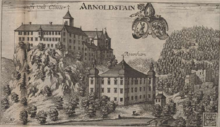Fuggerau

The Fuggerau was an ore smelting and mining management facility that the Fugger family built near Arnoldstein .
history
The name Fuggerau cannot be unequivocally traced back to the Fugger from the lily , as the name Fugger has been proven in the area before 1495 without any connection to the Augsburgers.
construction
The Fuggerau was built by the brothers Ulrich , Georg and Jakob in 1495 on grounds that they had acquired from Arnoldstein Abbey . This was done with the express permission of the Bamberg diocese , to which the monastery belonged, and with which the Fuggers were already doing business through their presence in Franconia . The following were regulated: water rights , property, fortification rights, everything as a pledge of the monastery for the Bamberg diocese, whereby the monastery in turn received compensation for the pledge. Furthermore, the right to cut wood at will, as well as to hunt and fish within certain limits. Further land purchases and pledges took place in 1496. The Fuggers were also allowed to exercise lower jurisdiction in the castle, while the higher jurisdiction remained with the Bamberg Vicedom for Carinthia .
business
The Fuggerau was a combination of Saigerhütten , hammer mill , brass foundry, cannon factory and stronghold, guarded by heavy cannons - the latter, by the way, its own products, as well as the 261 rifles that were recorded in 1504. The molten metal was inside the Burgbering , the brass hammers, since they needed water power, in the valley, probably on the Gailitz . The Fuggerau was conveniently located to process ores extracted from the area as well as those from Upper Hungary for the Venetian market. According to Pölnitz, the processed gold ore came from Klieming - it should be Kliening . The copper obtained was mostly implemented in Venice; the hut was considered efficient, between 1495 and 1504 50,000 Venetian hundredweight of copper and 22,000 Viennese silver marks were brought to Venice. For the period 1527 to 1546, 33 lead tunnels near the Fuggerau and in Bleiberg , in which the Fuggers were involved, are documented. The lead ore supply from Schwaz is also documented.
The first factor used by the Fugger Company was Hans Fugger vom Reh , cousin of Jacob the Rich, who died here in 1503; he was followed by Georg Fugger's sons-in-law Christoph Hering and, afterwards, Jobst Zeller, who was deposed because he was held responsible for the fact that the Venetians had succeeded in stealing the guns from the Fuggerau during their war with the League of Cambrai . In 1537 Gastel Fugger was the deer factor.
In 1530 the brass hammers were discontinued.
Decline

In 1547 the Fuggers withdrew from the Hungarian mining industry. With the restriction to domestic ores, the importance of the Fuggerau declined. That is why the brothers Marx and Hans Fugger sold the Fuggerau back to the monastery under Abbot Petrus von Arnoldstein in 1570 for 2500 guilders ; with all properties, facilities and rights, right up to the furniture. With the decay of the buildings, the field name Fuggerau also disappeared from the consciousness of the population. An engraving by Valvasor from 1688 shows a view of the ruin.
In 1814 the scrap tower Gailitz was built on the remains of the wall . Its successor from 1830 was operated until 1974 and is still preserved today.
literature
- Georg Lux, Helmuth Weichselbraun: Derelict & Forgotten - Lost Places in the Alps-Adriatic Region. Styria Verlag, Vienna / Graz / Klagenfurt 2017, ISBN 978-3-222-13551-4
See also
Individual evidence
- ↑ a b c d e f g h i j k Götz von Pölnitz: Jakob Fugger, Volume 2. pp. 34–38 , accessed on July 15, 2010 .
- ↑ Chronicle of lead and zinc mining in relation to the Bleiberger Bergwerk Union. Retrieved July 15, 2010 .
- ↑ Hans Krähenbühl: The spread of Tyrolean mining and its influence on Graubünden - 5. The coal and steel industry under the Austrian dukes. (PDF; 2.0 MB) (No longer available online.) Archived from the original on April 2, 2015 ; Retrieved July 15, 2010 . Info: The archive link was inserted automatically and has not yet been checked. Please check the original and archive link according to the instructions and then remove this notice.
- ↑ Mark Häberlein: The Fugger: History of an Augsburg family (1367-1650). P. 46 , accessed July 15, 2010 .
- ↑ Arnoldstein. Austria Forum , accessed on July 26, 2010 .
- ↑ Culture Trail. (No longer available online.) Archived from the original on November 3, 2015 ; Retrieved July 26, 2010 . Info: The archive link was inserted automatically and has not yet been checked. Please check the original and archive link according to the instructions and then remove this notice.
- ↑ Reinhold Gasper, Friedrich Hans Ucik: The former scrap tower near the Hollenburg (Southern Carinthia) and the other scrap towers in Carinthia and Austria, which was previously unknown in the specialist literature . In: Carinthia II . 2006, p. 2 ( PDF on ZOBODAT [accessed on January 29, 2017]).
Coordinates: 46 ° 32 '53.3 " N , 13 ° 41' 36.7" E
